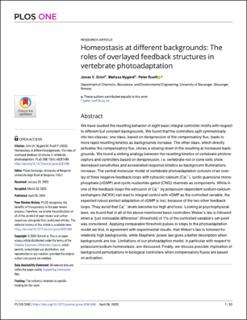| dc.contributor.author | Grini, Jonas V. | |
| dc.contributor.author | Nygård, Melissa | |
| dc.contributor.author | Ruoff, Peter | |
| dc.date.accessioned | 2023-06-19T06:57:58Z | |
| dc.date.available | 2023-06-19T06:57:58Z | |
| dc.date.created | 2023-06-05T13:23:13Z | |
| dc.date.issued | 2023 | |
| dc.identifier.citation | Grini, J.V., Nygård, M. & Ruoff, P. (2023) Homeostasis at different backgrounds: The roles of overlayed feedback structures in vertebrate photoadaptation. PLOS ONE, 18 (4). | en_US |
| dc.identifier.issn | 1932-6203 | |
| dc.identifier.uri | https://hdl.handle.net/11250/3071950 | |
| dc.description.abstract | We have studied the resetting behavior of eight basic integral controller motifs with respect to different but constant backgrounds. We found that the controllers split symmetrically into two classes: one class, based on derepression of the compensatory flux, leads to more rapid resetting kinetics as backgrounds increase. The other class, which directly activates the compensatory flux, shows a slowing down in the resetting at increased backgrounds. We found a striking analogy between the resetting kinetics of vertebrate photoreceptors and controllers based on derepression, i.e. vertebrate rod or cone cells show decreased sensitivities and accelerated response kinetics as background illuminations increase. The central molecular model of vertebrate photoadaptation consists of an overlay of three negative feedback loops with cytosolic calcium (cai2+), cyclic guanosine monophosphate (cGMP) and cyclic nucleotide-gated (CNG) channels as components. While in one of the feedback loops the extrusion of cai2+ by potassium-dependent sodium-calcium exchangers (NCKX) can lead to integral control with cGMP as the controlled variable, the expected robust perfect adaptation of cGMP is lost, because of the two other feedback loops. They avoid that cai2+ levels become too high and toxic. Looking at psychophysical laws, we found that in all of the above mentioned basic controllers Weber’s law is followed when a “just noticeable difference” (threshold) of 1% of the controlled variable’s set-point was considered. Applying comparable threshold pulses or steps to the photoadaptation model we find, in agreement with experimental results, that Weber’s law is followed for relatively high backgrounds, while Stephens’ power law gives a better description when backgrounds are low. Limitations of our photoadaption model, in particular with respect to potassium/sodium homeostasis, are discussed. Finally, we discuss possible implication of background perturbations in biological controllers when compensatory fluxes are based on activation. | en_US |
| dc.language.iso | eng | en_US |
| dc.rights | Navngivelse 4.0 Internasjonal | * |
| dc.rights.uri | http://creativecommons.org/licenses/by/4.0/deed.no | * |
| dc.title | Homeostasis at different backgrounds: The roles of overlayed feedback structures in vertebrate photoadaptation | en_US |
| dc.type | Peer reviewed | en_US |
| dc.type | Journal article | en_US |
| dc.description.version | publishedVersion | en_US |
| dc.rights.holder | © 2023 Grini et al. | en_US |
| dc.subject.nsi | VDP::Matematikk og Naturvitenskap: 400 | en_US |
| dc.source.volume | 18 | en_US |
| dc.source.journal | PLOS ONE | en_US |
| dc.source.issue | 4 | en_US |
| dc.identifier.doi | 10.1371/journal.pone.0281490 | |
| dc.identifier.cristin | 2151875 | |
| cristin.ispublished | true | |
| cristin.fulltext | original | |
| cristin.qualitycode | 1 | |

